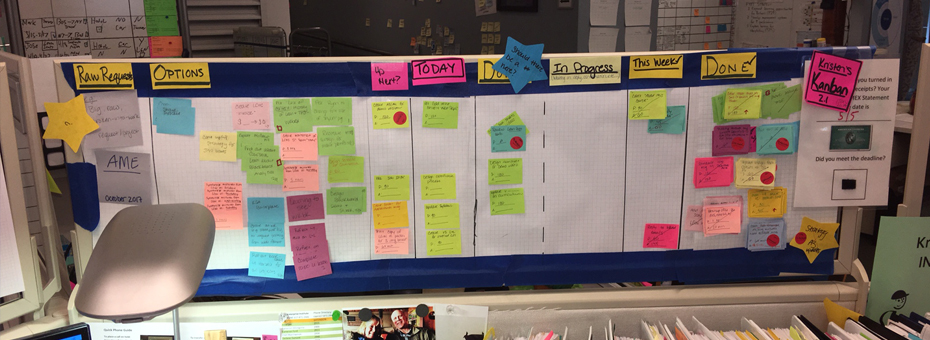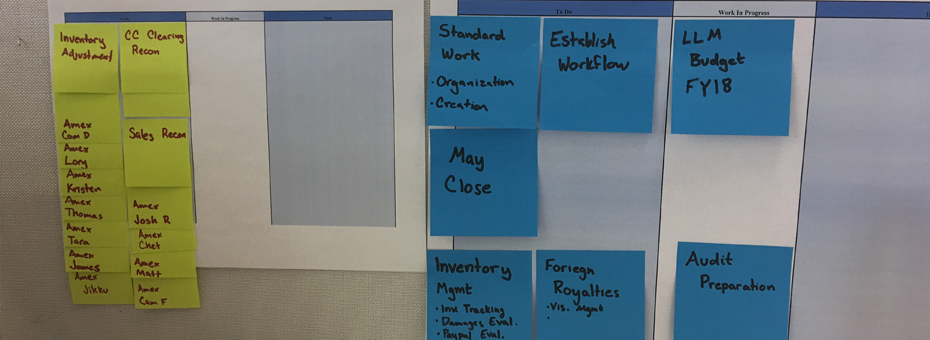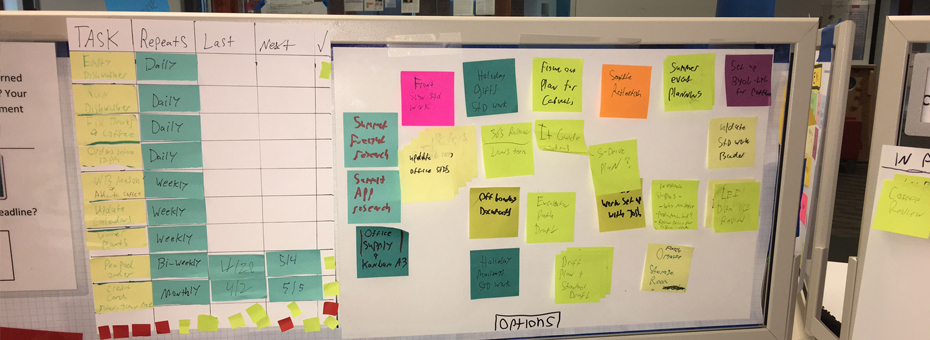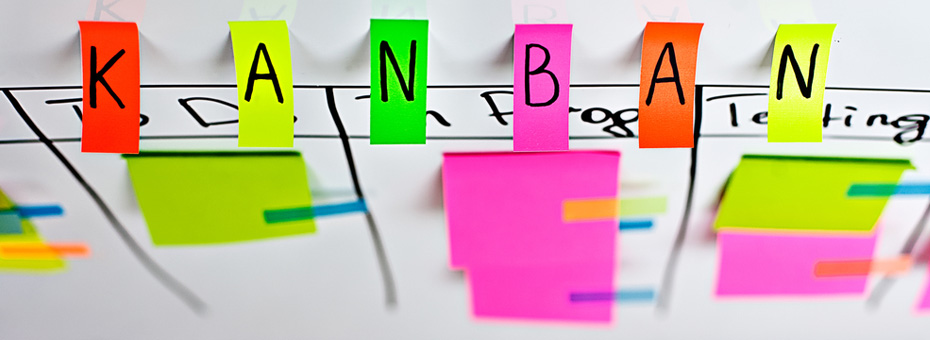Kanban boards. For many of us, they were the first visual management tools we used that taught us the benefits of lean. They’re simple, effective and easily customizable to suit your own unique work and challenges. Today, three of LEI’s relative newcomers to lean share their own personal kanban boards and the impact they’ve had on their work.
Kristen Gandek, Project Manager

I’ve been at LEI for about a year, and I’ve come to rely on several visual management tools. Just above my desk, I see my personal kanban board.
A standard kanban board has three columns: Options, Doing, Done. In addition, I added a “Today” column in front of my Doing column to help me see what is coming down the pipeline. This countermeasure helps me plan ahead. I also added an “In Progress” column between Doing and Done since, at times, my work relies on others before I move the task to Done. When I move an item to this column, I date it. Now I can see the item’s age and design an approach to keep the item moving towards completion.

In the “Options” column, colored Post-Its denote different projects and I draw a border on the Post-It if the task is a working session. The color key is next to the board. Each Post-It shows a “planned” amount of time, and when I complete the task I write the “actual.” If the actual does not match the planned, I know to start asking “why?”
In the past, when I got to the end of the day I saw that work under Doing had not moved to Done. Why was this? I did have unplanned work that wasn’t visible, and it wasn’t clear when a “Doing” task had been interrupted. I remembered working with my coach, Alice Lee, on a project where we tilted some Post-Its to differentiate them from others. This was simple, quick, and visually recognizable. Now, I tilt Post-Its to show interrupted work.
But how to show why it was interrupted? I had started using red dot stickers to show “unplanned” work (“unplanned” = unexpected work to be completed within 24 hours). Now, when I tilt a Post-It, I place a new one with a red dot on top to show why the planned work was interrupted. This way, when I look at my “doing” column, I can see immediately how many projects I plan to work on in a given day (how many colors are there?), how much time is planned out (add up the “planned” minutes of work), and if there is any unplanned work or interrupted work happening (are there any red dots or tilted Post-Its?).
James Connolly, Accounting & Inventory Associate
 Solid organizational systems have been a bit of a holy grail in my life since a young age. From a detailed homework assignment journal to an elaborately organized binder, teachers and parents have been trying to help me and the rest of my generation “get it together” since the first grade. However, it wasn’t until my introduction to lean that I started using organizational techniques that started making sense. Lean for me marked the introduction of visual management tools that not only work but also actively help my work. I am going to take this chance to mention the kanban board.
Solid organizational systems have been a bit of a holy grail in my life since a young age. From a detailed homework assignment journal to an elaborately organized binder, teachers and parents have been trying to help me and the rest of my generation “get it together” since the first grade. However, it wasn’t until my introduction to lean that I started using organizational techniques that started making sense. Lean for me marked the introduction of visual management tools that not only work but also actively help my work. I am going to take this chance to mention the kanban board.
The nature of finance runs contradictory to many lean principles. The nature of month-end reporting creates a batching tendency. The relevant information for such reports becomes available as soon as they are expected. And then the options become month-end batching or reworking the month-end processes throughout the month to get ahead of reporting. However, since introducing a dual kanban system I have been able to stay on top of the work throughout the month and minimize rework by visually tracking my accomplishments.
My dual kanban system lets me capture big-picture items on one board while breaking out the steps and action items of the work in progress. This lets me keep a finger on the pulse of what needs to get done on the first while giving me the flexibility to track the steps and reset weekly processes on the second. This process gives me real-time visibility for an otherwise difficult to track monthly process as I try to break it down to weekly and biweekly processes.

For example, let’s take the task of closing out the books for the previous month. This is a rather involved process requiring many subtasks to be completed. I will track the larger task (month-end) on my larger board, along with other unrelated tasks that need completing, while tracking the step-by-step processes in the second kanban board. It is important to note that the secondary kanban can only be used while the associated task is in the “Work in Progress” section of the larger. Otherwise you defeat the purpose of both.
Cameron DiGregorio, Office Coordinator
 As someone newer to lean, I have found great value in visual management, especially since much of my work in my day-to-day job as an office coordinator can be trapped on the computer and not as visual as I would like. I have several visual management tools within my space, but the one I have found to be the most helpful, and the one I am constantly working on and working to improve, would have to be my Personal Kanban chart.
As someone newer to lean, I have found great value in visual management, especially since much of my work in my day-to-day job as an office coordinator can be trapped on the computer and not as visual as I would like. I have several visual management tools within my space, but the one I have found to be the most helpful, and the one I am constantly working on and working to improve, would have to be my Personal Kanban chart.
One of the biggest struggles I encounter in my daily work is keeping track of priorities, and tracking adhoc projects that are added throughout the day. Before I had the kanban chart, I found I would often end up with several notebooks, or pages, with many different check lists. Oftentimes, instead of helping me track my “options” I would instead lose sight of my duties, and it could leave me scrambling to finish my projects. Additionally, I found that I didn’t have a great way to record adhoc projects without losing sight of my current task.

When I first started experimenting with the kanban board, my biggest challenge was getting myself in the habit of using it and making sure to record all assignments, even if they were a quick turnaround. I used to have the board up above me, but even the simple extra motion of standing up to add, move or change a task could cause me to ignore the board. But when I moved my board from above my computer monitor to down by my keyboard, I found having it within reach and in line of sight at all times led me to be more diligent about its use. Lately, one of the greatest values I take from it is helping me focus on my tasks without getting overwhelmed or distracted. With the kanban board, being able to take a moment, record all of those items and get them on to something physical, greatly helps me manage my stress, and priorities, which in turn helps me be a more productive employee.





